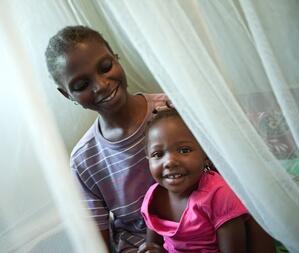
The implementation of prevention strategies intended to reduce the number of cases of malaria during pregnancy in sub-Saharan Africa has failed to meet international targets according to a study authored by researchers at the LSTM led Malaria in Pregnancy Consortium (MiP).
Malaria during pregnancy can have important consequences for both mother and baby, and yet the harmful effects are preventable. The adverse outcomes of malaria in pregnancy can be substantially reduced by interventions that have been available for over two decades and are inexpensive and cost effective; however the access and use of these interventions have been traditionally low, representing a failure in public health systems.
The study, which was published in the Lancet Infectious Diseases, on 18th September 2013, set out to review the extent to which intermittent preventative treatment (IPTp), which until recently comprised two doses of sulfadoxine-pyrimethamine, and insecticide treated nets (ITNs) were used by pregnant women, exploring associations between coverage and individual and country-level factors.
Authored by Annemieke van Eijk, Jenny Hill and Feiko ter Kuile of LSTM, together colleagues from the Program for Appropriate Technology in Health (PATH), the London School of Tropical Medicine and Hygiene (LSTHM) and Tulane University, the study follows on from their previous work that was published in same journal in March 2011.The team used data from nationally representative household surveys from 2009 to 2011 to estimate coverage of IPTp, the use of ITNs and attendance at antenatal clinics.
The study found that while coverage of IPTp and use of ITNs in most of the countries targeted had increased, it remains far below the 80% target set by the Role Back Malaria (RBM) partnership despite fairly high rates of attendance at antenatal clinics. The use of ITNs was higher in areas with both a high disbursement of funds for malaria control, high total fertility rate and a lower per-head gross domestic product (GDP), whereas richer, educated and urban women were more likely to access IPTp than their poor, uneducated, rural counterparts.
Lead author, Annemieke van Eijk said: “Coverage of both IPTp andITNs have increased in most countries which is clearly positive, but is still below the relatively high number antenatal clinic attendance rates among pregnant women. This demonstrates lost opportunities at antenatal clinics and further improvement in delivery of these interventions through antenatal care are required in order to protect the millions of pregnancies exposed to malaria in sub-Saharan Africa each year.”
Coverage of intermittent preventive treatment and insecticide-treated nets for the control of malaria during pregnancy in sub-Saharan Africa: a synthesis and meta-analysis of national survey data, 2009–11
Dr Anna Maria van Eijk MD,Jenny Hill MSc,David A Larsen PhD,Jayne Webster PhD,Richard W Steketee MD,Thomas P Eisele PhD,Prof Feiko O ter Kuile MD